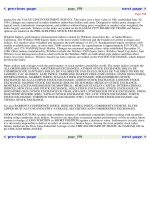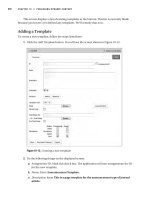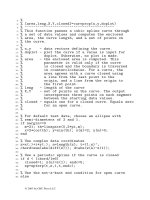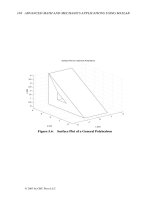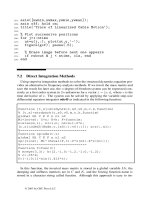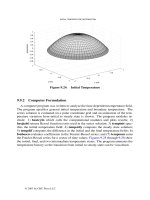Advanced Mathematics and Mechanics Applications Using MATLAB phần 9 pps
Bạn đang xem bản rút gọn của tài liệu. Xem và tải ngay bản đầy đủ của tài liệu tại đây (6.37 MB, 67 trang )
86: print(’Input data are incorrect. The ’);
87: print(’following r values lie outside the ’);
88: print(’unit circle:’); disp(rvec(kout)’);
89: return
90: end
91:
92:
if bvtyp==1 % Solve a Dirichlet problem
93: % Check for points on the boundary where
94: % function values are known. Interpolate
95: % these directly
96: konbd=find(r==1); onbndry=length(konbd);
97: if onbndry > 0
98: u(konbd)=lintrp(thbv,fbv,th(konbd));
99: end
100:
101:
% Evaluate the series solution
102: kinsid=find(r<1); inside=length(kinsid);
103:
104:
if inside > 0
105: a=fft(lintrp(thbv,fbv,thfft));
106: a=a(1:nsum)/(nft/2);
107: a(1)=a(1)/2; Z=r(kinsid).*exp(i*th(kinsid));
108: u(kinsid)=real(polyval(flipud(a(:)),Z));
109: end
110:
111:
titl=
112: ’Dirichlet Problem Inside the Unit Circle’;
113:
114:
else % Solve a Neumann problem
115: gbv=lintrp(thbv,fbv,thfft);
116: a=fft(gbv)/(nft/2);
117: erchek=abs(a(1))/sum(abs(gbv));
118: if erchek>1e-3
119: disp(’ ’);
120: disp(’ERROR DUE TO NONZERO AVERAGE VALUE’);
121: disp(’OF NORMAL GRADIENT ON THE BOUNDARY.’);
122: disp(’CORRECT THE INPUT DATA AND RERUN.’);
123: disp(’ ’); u=[]; r=[]; th=[]; return;
124: end
125: a=a(2:nsum)./(1:nsum-1)’; z=r.*exp(i*th);
126: u=real(polyval(flipud([0;a(:)]),z));
127: titl=’Neumann Problem Inside the Unit Circle’;
128: end
129:
130:
u=reshape(u,nth,nr); r=R; th=Th;
© 2003 by CRC Press LLC
131: surf(r.*cos(th),r.*sin(th),u);
132: xlabel(’x axis’); ylabel(’y axis’);
133: zlabel(’function u’); title(titl);
134: colormap(’default’);
135: grid on; figure(gcf);
136: % print -deps dirich
137:
138:
%=============================================
139:
140:
% function y=lintrp(xd,yd,x)
141: % See Appendix B
Function cauchtst
1: function u=cauchtst(z,nquad)
2: %
3: % u=cauchtst(z,nquad)
4: % ~~~~~~~~~~~~~~~~~~~
5: %
6: % This function solves a mixed boundary
7: % value problem for the interior of a circle
8: % by numerically evaluating a Cauchy integral.
9: %
10: % z - matrix of complex coordinates where
11: % function values are computed
12: % nquad - order of Gauss quadrature used to
13: % perform numerical integration
14: %
15: % u - computed values of the approximate
16: % solution
17: %
18: % User m functions called: cauchint, mbvtest,
19: % gcquad, splined
20:
21:
if nargin<2, nquad=50; end; nbdat=61;
22: if nargin==0
23: z=linspace(0,.99,10)’*
24: exp(i*linspace(0,2*pi,91));
25: end
26: th=linspace(-pi/2,pi/2,nbdat); zb=exp(i*th);
27: fb=sqrt(zb-i).*sqrt(zb+i); fb(1)=1; fb(nbdat)=1;
© 2003 by CRC Press LLC
28: fb=cos(th)./fb; fb(1)=0; fb(end)=0;
29: F=cauchint(fb,zb,z,nquad);
30: F=F.*sqrt(z-i).*sqrt(z+i); u=2*real(F);
31:
32:
surf(real(z),imag(z),u); xlabel(’x axis’);
33: ylabel(’y axis’); zlabel(’Solution Value’)
34: title([’Approximate Solution to ’,
35: ’a Mixed Boundary Value Problem’]);
36: grid on; figure(gcf); %gra(.4);
37: fprintf(’\nPress [Enter] to solution error\n’);
38: pause
39: %print -deps caucher1
40: uexact=mbvtest(z,1); udif=u-uexact;
41: clf; surf(real(z),imag(z),udif);
42: title([’Difference Between Exact and ’,
43: ’Approximate Solutions’]);
44: xlabel(’x axis’); ylabel(’y axis’);
45: zlabel(’Solution Error’)
46: grid on; figure(gcf); %gra(.4)
47: %print -deps caucher2
48:
49:
%=============================================
50:
51:
function u=mbvtest(z,noplot)
52: %
53: % u=mbvtest(z,noplot)
54: % ~~~~~~~~~~~~~~~~~~~
55: %
56: % This function determines a function which is
57: % harmonic for abs(z)<1 and satisfies at r=1,
58: % u=cos(theta), -pi/2<theta<pi/2
59: % du/dr=0, pi/2<theta<3*pi/2
60: % The solution only applies for points inside
61: % or on the unit circle.
62: %
63: % z - matrix of complex values where the
64: % solution is computed.
65: % noplot - option set to one if no plot is
66: % requested, otherwise option is not
67: % required.
68: %
69: % u - values of the harmonic function
70: % defined inside the unit circle
71: %
72: % User m functions called: none
© 2003 by CRC Press LLC
73: %
74:
75:
if nargin==0
76: noplot=0;
77: z=linspace(0,1,10)’*
78: exp(i*linspace(0,2*pi,81));
79: end
80: [n,m]=size(z); z=z(:); u=1/2*ones(size(z));
81: k=find(abs(z)>0); Z=z(k);
82: U=(Z+1./Z+(1-1./Z).*sqrt(Z-i).*sqrt(Z+i))/2;
83: u(k)=real(U); u=reshape(u,n,m);
84: if nargin==1 | noplot==0
85: z=reshape(z,n,m);
86: surf(real(z),imag(z),u); xlabel(’x axis’);
87: ylabel(’y axis’);
88: title([’Mixed Boundary Value Problem ’,
89: ’for a Circular Disk’]);
90: grid; figure(gcf); %gra(.4), pause
91: %print -deps mbvtest
92: end
93:
94:
%=============================================
95:
96:
function F=cauchint(fb,zb,z,nquad)
97: %
98: % F=cauchint(fb,zb,z,nquad)
99: % ~~~~~~~~~~~~~~~~~~~~~~~~~
100: %
101: % This function numerically evaluates a Cauchy
102: % integral of the form:
103: %
104: % F(z)=1/(2*pi*i)*Integral(f(t)/(t-z)*dt)
105: %
106: % where t denotes points on a curve in the
107: % complex plane. The boundary curve is defined
108: % by spline interpolation through data points
109: % zb lying on the curve. The values of f(t)
110: % are also specified by spline interpolation
111: % through values fb corresponding to the
112: % points zb. Numerical evaluation of the
113: % integral is performed using a composite
114: % Gauss formula of arbitrary order.
115: %
116: % fb - values of density function f
117: % at point on the curve
© 2003 by CRC Press LLC
118: % zb - points where fb is given. The
119: % number of values of zb must be
120: % adequate to define the curve
121: % accurately.
122: % z - a matrix of values at which the
123: % Cauchy integral is to be evaluated.
124: % If any of the z-values lie on path
125: % of integration or too close to the
126: % path of integration, incorrect
127: % results will be obtained.
128: % nquad - the order of Gauss quadrature
129: % formula used to perform numerical
130: % integration
131: %
132: % F - The value of the Cauchy integral
133: % corresponding to matrix argument z
134: %
135: % User m functions called: gcquad splined
136: %
137:
138:
n=length(fb); [nr,nc]=size(z); z=z(:).’;
139: nz=length(z); t=1:n;
140: [dummy,bp,wf]=gcquad(’’,1,n,nquad,n-1);
141: fq=spline(t,fb,bp); zq=spline(t,zb,bp);
142: zqd=splined(t,zb,bp); nq=length(fq);
143: fq=fq(:).*zqd(:);
144:
145:
bdrylen=sum(abs(zq(2:nq)-zq(1:nq-1)));
146:
147:
closnes=1e100; bigz=max(abs(z));
148: for j=1:nq
149: closnes=min([closnes,abs(zq(j)-z)]);
150: end
151: if closnes/bdrylen<.01 | closnes/bigz<.01
152: disp(’ ’)
153: disp([’WARNING! SOME DATA VALUES ARE ’,
154: ’EITHER NEAR OR ON’]);
155: disp([’THE BOUNDARY. COMPUTED RESULTS ’,
156: ’MAY BE INACCURATE’]); disp(’ ’)
157: end
158: F=wf(:)’*(fq(:,ones(1,nz))./(zq(:,ones(1,nz))
159: -z(ones(nq,1),:)));
160: F=reshape(F,nr,nc)/(2*pi*i);
161:
162:
%=============================================
© 2003 by CRC Press LLC
163:
164:
% function [val,bp,wf]=gcquad(func,xlow,
165: % xhigh,nquad,mparts,varargin)
166: % See Appendix B
167:
168:
%=============================================
169:
170:
% function val=splined(xd,yd,x,if2)
171: % See Appendix B
12.12 Inviscid Fluid Flow around an Elliptic Cylinder
This section analyzes inviscid ßow around an elliptic cylinder in an inÞnite Þeld.
Flow around a circular cylinder is treated Þrst. Then the function conformally map-
ping the exterior of a circle onto the exterior of an ellipse is used in conjunction with
the invariance of harmonic functions under a conformal transformation. Results de-
scribing the elliptic cylinder ßow Þeld for uniform velocity components at inÞnity
are presented.
Let us solve for the ßow around a circular cylinder in the region |ζ|≥1, ζ = ξ+iη
with the requirement that the velocity components at inÞnity have constant values
u = U,v= V
where (u, v) are the horizontal and vertical components of velocity. These compo-
nents are derivable from a potential function φ such that
u =
∂φ
∂ξ
,v=
∂φ
∂η
where φ is a harmonic function. The velocity normal to the cylinder boundary must
be zero. This requires that the function ψ, the harmonic conjugate of φ, must be con-
stant on the boundary. The constant can be taken as zero without loss of generality.
In terms of the complex velocity potential
f(ζ)=φ + iψ
we need
f(ζ) −
f(ζ)=0 on |ζ| =1
The velocity Þeld is related to the complex velocity potential by
u −iv = f
(ζ)
so the ßow condition at inÞnity is satisÞed by
f(ζ)=pζ + O(1) where p = U − iV
© 2003 by CRC Press LLC
A Laurent series can be used to represent f (ζ) in the form
f(ζ)=pζ + a
0
+
∞
n=1
a
n
ζ
−n
Imposition of the boundary condition on the cylinder surface requiring
f(σ) −
f(σ)=0 where σ = e
ıθ
leads to
pσ + a
0
+
∞
n=1
a
n
σ
−n
− ¯pσ
−1
− a
0
−
∞
n=1
a
n
σ
n
=0
Taking a
0
=0, a
1
=¯p, and a
n
=0,n≥ 2 satisÞes all conditions of the problem
and yields
f(ζ)=pζ +¯pζ
−1
as the desired complex potential function giving the velocity Þeld as
u −iv = f
(ζ)=p − ¯pζ
−2
, |ζ|≥1
Now consider ßow about an elliptic cylinder lying in the z-plane. If the velocity
at inÞnity has components (U, V ) then we need a velocity potential F (z) such that
F
(∞)=U −iV and
F (z) −
F (z)=0 for
x
a
2
+
y
b
2
=1
This is nearly the same problem as was already solved in the ζ-plane except that
dF
dz
=
dζ
dz
dF
dζ
=
1
ω
(ζ)
dF
dζ
where ω(ζ) is the mapping function
z = ω(ζ)=R(ζ + mζ
−1
) ,R=
a + b
2
,m=
a −b
a + b
In terms of ζ we would need
dF
dζ
= ω
(∞)[U − iV ]=R(U − iV ) at ζ = ∞
Consequently, the velocity potential for the elliptic cylinder problem expressed in
terms of ζ is
F = pζ +¯pζ
−1
,p= R(U − ıV )
and the velocity components in the z-plane are given by
u −iv =
1
ω
(ζ)
p − ¯pζ
−2
=
(U − iV ) − (U − iV )ζ
−2
1 −mζ
−2
.
© 2003 by CRC Press LLC
To get values for a particular choice of z we can use the inverse mapping function
ζ =
z +
√
z
2
− 4mR
2
2R
to eliminate ζ or we can compute results in terms of ζ.
To complete our discussion of this ßow problem we will graph the lines charac-
terizing the directions of ßow. The velocity potential F = φ + iψ satisÞes
u =
∂φ
∂x
=
∂ψ
∂y
,v=
∂φ
∂y
= −
∂ψ
∂x
so a curve tangent to the velocity Þeld obeys
dy
dx
=
v
u
= −
∂ψ/∂x
∂ψ/∂y
or
∂ψ
∂x
dx +
∂ψ
∂y
dy =0 ,ψ= constant
Consequently, the ßow lines are the contours of function ψ, which is called the
stream function. The function we want to contour does not exist inside the ellipse,
but we can circumvent this problem by computing ψ in the ellipse exterior and then
setting ψ to zero inside the ellipse. The function elipcyl analyzes the cylinder ßow
and produces the accompanying contour plot shown in Figure 12.9.
© 2003 by CRC Press LLC
−5 −4 −3 −2 −1 0 1 2 3 4 5
−5
−4
−3
−2
−1
0
1
2
3
4
5
x axis
y axis
Elliptic Cylinder Flow Field for Angle = 30 Degrees
Figure 12.9: Elliptic Cylinder Flow Field for Angle = 30
◦
12.12.1 Program Output and Code
Function elipcyl
1: function [x,y,F]=elipcyl(a,n,rx,ry,ang)
2: %
3: % [x,y,F]=elipcyl(a,n,rx,ry,ang)
4: % ~~~~~~~~~~~~~~~~~~~~~~~~~~~~~~
5: %
6: % This function computes the flow field around
7: % an elliptic cylinder. The velocity direction
8: % at infinity is arbitrary.
9: %
10: % a - defines the region -a<x<a, -a<y<a
11: % within which the flow field is
12: % computed
13: % n - this determines the grid size which
14: % uses n by n points
15: % rx,ry - major and minor semi-diameters af the
16: % ellipse lying on the x and y axes,
© 2003 by CRC Press LLC
17: % respectively
18: % ang - the angle in degrees which the
19: % velocity at infinity makes with the
20: % x axis
21: %
22: % x,y - matrices of points where the velocity
23: % potential is computed
24: % F - matrix of complex velocity potential
25: % values. This function is set to zero
26: % inside the ellipse, where the
27: % potential is actually not defined
28: %
29: % User m functions called: none
30:
31:
% default data for a 2 by 1 ellipse
32: if nargin==0
33: a=5; n=81; rx=2; ry=1; ang=30;
34: end
35:
36:
% Compute a square grid in the z plane.
37: ar=pi/180*ang; p=(rx+ry)/2*exp(-i*ar);
38: cp=conj(p); d=linspace(-a,a,n);
39: [x,y]=meshgrid(d,d); m=sqrt(rx^2-ry^2);
40:
41:
% Obtain points in the zeta plane outside
42: % the ellipse
43: z=x(:)+i*y(:); k=find((x/rx).^2+(y/ry).^2>=1);
44: Z=z(k); zeta=(Z+sqrt(Z-m).*sqrt(Z+m))/(rx+ry);
45: F=zeros(n*n,1);
46:
47:
% Evaluate the potential for a circular
48: % cylinder
49: F(k)=p*zeta+cp./zeta; F=reshape(F,n,n);
50:
51:
% Contour the stream function to show the
52: % direction of flow
53:
54:
clf; contourf(x(1,:),y(:,1),abs(imag(F)),30);
55: axis(’square’); zb=exp(i*linspace(0,2*pi,101));
56: xb=rx*real(zb); yb=ry*imag(zb);
57: xb(end)=xb(1); yb(end)=yb(1);
58: hold on; fill(xb,yb,[127/255 1 212/255]);
59: xlabel(’x axis’); ylabel(’y axis’);
60: title([’Elliptic Cylinder Flow Field for ’,
61: ’Angle = ’,num2str(ang),’ Degrees’]);
© 2003 by CRC Press LLC
62: colormap hsv; figure(gcf); hold off;
63: %print -deps elipcyl
12.13 Torsional Stresses in a Beam Mapped onto a Unit Disk
Torsional stresses in a cylindrical beam can be computed from an integral formula
when the function z = ω(ζ) mapping the unit disk, |ζ|≤1, onto the beam cross
section is known [90]. The complex stress function
f(ζ)=
1
2π
γ
ω(σ)ω(σ) dσ
σ − ζ
+ constant,
where γ denotes the unit circle, can be evaluated exactly by contour integration in
some cases. However, an approach employing series methods is easy to implement
and gives satisfactory results if enough series terms are taken. When ω(ζ) is a poly-
nomial, f (ζ) is a polynomial of the same order as ω(ζ). Furthermore, when ω(ζ)
is a rational function, residue calculus can be employed to compute f (ζ) exactly,
provided the poles of
ω(1/ζ) can be found. A much simpler approach is to use the
FFT to expand ω(σ)
ω(σ) in a complex Fourier series and write
ω(σ)
ω(σ)=
∞
n=−∞
c
n
σ
n
,σ= e
ıθ
Then the complex stress function is
f(ζ)=i
∞
n=1
c
n
ζ
n
+ constant
where the constant has no inßuence on the stress state. The shear stresses relative to
the curvilinear coordinate system are obtainable from the formula
τ
ρZ
− iτ
αZ
µε
=
f
(ζ) − iω(ζ)ω
(ζ)
ζ
|ζω
(ζ)|
where µ is the shear modulus and ε is the angle of twist per unit length. The capital
Z subscript on shear stresses refers to the direction of the beam axis normal to the
xy plane rather than the complex variable z = x + ıy. The series expansion gives
f
(ζ)=i
∞
n=1
nc
n
ζ
n−1
and this can be used to compute stresses. Differentiated series expansions often
converge slowly or may even be divergent. To test the series expansion solution, a
© 2003 by CRC Press LLC
0 0.1 0.2 0.3 0.4 0.5 0.6 0.7 0.8 0.9 1
−0.1
0
0.1
0.2
0.3
0.4
0.5
0.6
0.7
y distance along the side
shear stresses at the boundary
Torsional Shear Stresses on a Square Cross Section
Max Shear Stress = 0.67727
Number of Series Terms = 800
Maximum Stress Error = 0.44194%
Stiffness Factor Error = 0.052216%
Radial shear stress
Tangential shear stress
Figure 12.10: Torsional Shear Stresses on a Square Cross Section
rational function mapping |ζ| < 1 onto a square deÞned by |x|≤1 and |y|≤1 was
employed. Function mapsqr which computes z(ζ) and z
(ζ) is used by function
torstres to evaluate stresses in terms of ζ. A short driver program runtors evaluates
stresses on the boundary for x =1, 0 ≤ y ≤ 1. Stresses divided by the side length of
2 are plotted and results produced from a highly accurate solution [90] are compared
with values produced using 800 terms in f(ζ). Results depicted in Figure 12.10
show that the error in maximum shear stress was only 0.44% and the torsional stiff-
ness was accurate within 0.05%. The numerical solution gives a nonzero stress value
for y =1, which disagree with the exact solution. This error is probably due more to
the mapping function giving slightly rounded corners than to slow convergence of the
series solution. Even though the differentiated series converges slowly, computation
time is still small. The reader can verify that using 1500 terms reduces the bound-
ary stress oscillations to negligible magnitude and produces a maximum stress error
of 0.03%. Although taking 1500 terms to achieve accurate results seems excessive,
less than 400 nonzero terms are actually involved because geometrical symmetry im-
plies a series increasing in powers of four. For simplicity and generality, no attempt
was made to account for geometrical symmetry exhibited by a particular mapping
function. It appears that a series solution employing a mapping function is a viable
computational tool to deal with torsion problems.
© 2003 by CRC Press LLC
12.13.1 Program Output and Code
Program runtors
1: function runtors(ntrms)
2: % Example: runtors(ntrms)
3: % ~~~~~~~~~~~~~~~~
4: %
5: % Example showing torsional stress computation
6: % for a beam of square cross section using
7: % conformal mapping and a complex stress
8: % function.
9: %
10: % ntrms - number of series terms used to
11: % represent abs(w(zeta))^2
12: %
13: % User m functions called: torstres, mapsqr
14:
15:
% Generate zeta values defining half of a side
16: theta=linspace(0,pi/4,501); zeta=exp(i*theta);
17: if nargin==0, ntrms=800; end
18:
19:
% Compute stresses using an approximate rational
20: % function mapping function for the square
21: [tr,ta,z,c,C]=
22: torstres(’mapsqr’,zeta,ntrms,4*1024);
23:
24:
% Results from the exact solution
25: n=1:2:13;
26: tmexact=1-8/pi^2*sum(1./(n.^2.*cosh(n*pi/2)));
27: err=abs(ta(1)/2-tmexact)*100/tmexact;
28: stfexct=16/3-1024/pi^5*sum(tanh(pi/2*n)./n.^5);
29: stfaprx=8/3-pi*sum((1:ntrms)’.*
30: abs(C(2:ntrms+1)).^2);
31: ster=100*abs(stfaprx-stfexct)/stfexct;
32:
33:
% Plot circumferential and normal stresses at
34: % the boundary
35: th=180/pi*theta;
36: clf; plot(imag(z),tr/2,’k:’,imag(z),ta/2,’k-’)
37: xlabel(’y distance along the side’);
38: ylabel(’shear stresses at the boundary’);
39: title([’Torsional Shear Stresses on a ’,
40: ’Square Cross Section’]);
© 2003 by CRC Press LLC
41: text(.05,.40,
42: [’Max Shear Stress = ’,num2str(max(ta)/2)]);
43: text(.05,.34,
44: [’Number of Series Terms = ’,num2str(ntrms)]);
45: text(.05,.28,
46: [’Maximum Stress Error = ’,num2str(err),’%’]);
47: text(.05,.22,[’Stiffness Factor Error = ’,
48: num2str(ster),’%’]);
49: legend(’Radial shear stress’,
50: ’Tangential shear stress’);
51: figure(gcf);
52: %disp(’Use mouse to locate legend block’);
53: %disp(’Press [Enter] when finished’);
54: %print -deps torsion
55:
56:
%=============================================
57:
58:
function [trho,talpha,z,c,C]=
59: torstres(mapfun,zeta,ntrms,nft)
60: %
61: % [trho,talpha,z,c,C]=
62: % torstres(mapfun,zeta,ntrms,nft)
63: % ~~~~~~~~~~~~~~~~~~~~~~~~~~~~~~~~~~~~~~~~~~~~~
64: %
65: % This function computes torsional stresses in
66: % a beam such that abs(zeta)<=1 is mapped onto
67: % the beam cross section by a function named
68: % mapfun.
69: %
70: % mapfun - a character string giving the name
71: % of the mapping function
72: % zeta - values in the zeta plane
73: % corresponding to which torsional
74: % stresses are computed
75: % ntrms - the number of terms used in the
76: % series expansion of the mapping
77: % function
78: % nft - the number of function values
79: % employed to compute Fourier
80: % coefficients of the complex stress
81: % function
82: %
83: % trho - torsional stresses in directions
84: % normal to the lines into which
85: % abs(zeta)=const map. These values
© 2003 by CRC Press LLC
86: % should be zero at the boundary
87: % corresponding to abs(zeta)=1.
88: % talpha - torsional stresses in directions
89: % tangent to the curves into which
90: % abs(zeta)=const map. The maximum
91: % value of shear stress always occurs
92: % at some point on the boundary defined
93: % by abs(zeta)=1.
94: % z - values of z where stresses are
95: % computed
96: % c - coefficients in the series expansion
97: % of the complex stress function
98: % C - complex Fourier coefficients of
99: % z.*conj(z) on the boundary of the
100: % beam cross section
101: %
102: % User m functions called: none
103: %
104:
105:
if nargin<4, nft=4096; end;
106: if nargin<3, ntrms=800; end
107:
108:
% Compute boundary values of the mapping
109: % function needed to construct the complex
110: % stress function
111: zetab=exp(i*linspace(0,2*pi*(nft-1)/nft,nft));
112: zb=feval(mapfun,zetab); zb=zb(:);
113:
114:
% Evaluate z and z’(zeta) at other
115: % desired points
116: [z,zp]=feval(mapfun,zeta);
117:
118:
% Compute Fourier coefficients for the complex
119: % stress function and its derivative
120: C=fft(zb.*conj(zb))/nft;
121: c=i*C(2:ntrms+1).*(1:ntrms)’;
122: fp=polyval(flipud(c),zeta);
123:
124:
% Evaluate stresses relative to the curvilinear
125: % coordinate system
126: tcplx=zeta./abs(zeta.*zp).*(fp-i*conj(z).*zp);
127:
128:
% trho is the radial shear stress that should
129: % vanish at the boundary
130: trho=real(tcplx);
© 2003 by CRC Press LLC
131:
132:
% talpha is the circumferential stress which
133: % gives the maximum stress of interest at the
134: % boundary
135: talpha=-imag(tcplx);
136:
137:
%=============================================
138:
139:
function [z,zp]=mapsqr(zeta);
140: %
141: % [z,zp]=mapsqr(zeta)
142: % ~~~~~~~~~~~~~~~~~~~
143: %
144: % This function maps the interior of a circle
145: % onto the interior of a square using a rational
146: % function of the approximate form:
147: %
148: % z(zeta)=zeta*Sum(a(j)*
149: % zeta4^(j-1)/(1+Sum(b(j)*zeta4^(j-1))
150: %
151: % where zeta4=zeta^4
152: %
153: % zeta - matrix of complex values such that
154: % abs(zeta)<=1
155: % z,zp - matrices of values of the mapping
156: % function and its first derivative
157: %
158: % User m functions called: none
159: %
160:
161:
a=[ 1.07835, 1.37751, -0.02642, -0.09129,
162: 0.13460, -0.15763, 0.07430, 0.14858,
163: 0.01878, -0.00354 ]’;
164: b=[ 1.37743, 0.07157, -0.11085, 0.12778,
165: -0.13750, 0.05313, 0.14931, 0.02683,
166: -0.00350, -0.000120 ]’;
167:
168:
% Evaluate the mapping function
169: zeta4=zeta.^4; p=zeta.*polyval(flipud(a),zeta4);
170: q=polyval(flipud([1;b]),zeta4); z=p./q;
171:
172:
% Exit if the derivative of z is not needed
173: if nargout==1, return, end
174:
175:
% evaluate z’(zeta)
© 2003 by CRC Press LLC
176: na=length(a); nb=length(b);
177: pp=polyval(flipud((4*(1:na)’-3).*a),zeta4);
178: qp=4*zeta.^3.*polyval(flipud((1:nb)’.*b),zeta4);
179: zp=(q.*pp-p.*qp)./q.^2;
12.14 Stress Analysis by the Kolosov-Muskhelishvili Method
Two-dimensional problems in linear elastostatics of homogeneous bodies can be
analyzed with the use of analytic functions. The primary quantities of interest are
cartesian stress components τ
xx
, τ
yy
, and τ
xy
and displacement components u and
v. These can be expressed as
τ
xx
+ τ
yy
=2[Φ(z)+Φ(z)]
−τ
xx
+ τ
yy
+2iτ
xy
=2[¯zΦ
(z)+Ψ(z)]
2µ(u + iv)=κφ(z) −z
Φ(z) −ψ(z)
φ(z)=
Φ(z) dz , ψ(z)=
Ψ(z) dz
where µ is the shear modulus and κ depends on Poisson’s ratio ν according to
κ =3− 4ν for plane strain or κ =(3− ν)/(1 + ν) for plane stress. The above
relations are known as the Kolosov-Muskhelishvili formulas [73] and they have been
used to solve many practical problems employing series or integral methods. Bod-
ies such as a circular disk, a plate with a circular hole, and a circular annulus can
be handled for quite general boundary conditions. Solutions can also be developed
for geometries where a rational function is known that maps the interior of a circle
onto the desired geometry. Futhermore, complex variable methods provide the most
general techniques available for solving a meaningful class of mixed boundary value
problems such as contact problems typiÞed by pressing a rigid punch into a half
plane.
Fully understanding all of the analyses presented in [72, 73] requires familiarity
with contour integration, conformal mapping, and multivalued functions. However,
some of the closed form solutions given in these texts can be used without extensive
background in complex variable methods or the physical concepts of elasticity the-
ory. With that perspective let us examine the problem of computing stresses in an
inÞnite plate uniformly stressed at inÞnity and having a general normal stress N(θ)
and tangential shear T (θ) applied to the hole. We will use the general solution of
Muskhelishvili
1
[72] to evaluate stresses anywhere in the plate with particular inter-
est on stress concentrations occurring around the hole. The stress functions Ψ and Φ
1
Chapter 20.
© 2003 by CRC Press LLC
can be represented as follows
Φ(z)=−
1
2πı
γ
(N + ıT)dσ
σ − z
+ α + βz
−1
+ δz
−2
,σ= e
ıθ
where γ denotes counterclockwise contour integration around the boundary of the
hole and the other constants are given by
α =
τ
∞
xx
+ τ
∞
yy
4
,δ=
−τ
∞
xx
+ τ
∞
yy
+2ıτ
∞
xy
2
β = −
κ
1+κ
1
2π
2π
0
(N + ıT )e
iθ
dθ
Parameters α and δ depend only on the components of stress at inÞnity, while β is
determined by the force resultant on the hole caused by the applied loading. The
quantity N + ıT is the boundary value of radial stress τ
rr
and shear stress τ
rθ
in
polar coordinates. Hence
N + ıT = τ
rr
+ iτ
rθ
, |z| =1
The transformation formulas relating Cartesian stresses τ
xx
, τ
yy
, τ
xy
and polar co-
ordinate stresses τ
rr
, τ
θθ
, τ
rθ
are
τ
rr
+ τ
θθ
= τ
xx
+ τ
yy
, −τ
rr
+ τ
θθ
+2ıτ
rθ
=(−τ
xx
+ τ
yy
+2iτ
xy
)e
2ıθ
Let us assume that N + ıT is expandable in a Fourier series of the form
N + ıT =
∞
n=−∞
c
n
σ
n
,σ= e
iθ
where c
n
can be obtained by integration as
c
n
=
1
2π
2π
0
(N + iT )σ
−n
dθ
or we can compute the approximate coefÞcients more readily using the FFT.
The stress function Ψ(z) is related to Φ(z) according to
Ψ=
1
z
2
Φ
1
¯z
−
d
dz
1
z
Φ(z)
, |z|≥1
Substituting the complex Fourier series into the integral formula for Φ gives
Φ=−
∞
n=0
c
n
z
n
+ α + βz
−1
+ δz
−2
, |z|≤1
Φ=
∞
n=1
c
−n
z
−n
+ α + βz
−1
+ δz
−2
, |z|≥1
© 2003 by CRC Press LLC
which has the form
Φ=
∞
n=0
a
n
z
−n
, |z|≥1
These two relations then determine Ψ as
Ψ=
¯
δ +
¯
βz
−1
+(α + a
0
− c
0
)z
−2
+
∞
n=3
[(n −1)a
n−2
− c
n−2
] z
−n
The last equation has the form
Ψ=
∞
n=0
b
n
z
−n
, |z|≥1
where the coefÞcients b
n
are obtainable by comparing coefÞcients of corresponding
powers in the two series. Hence, the series expansions of functions Φ(z) and Ψ(z)
can be generated in terms of the coefÞcients c
n
and the stress components at inÞn-
ity. The stresses can be evaluated by using the stress functions. Displacements can
also be obtained by integrating Φ and Ψ, but this straightforward calculation is not
discussed here.
The program runplate was written to evaluate the above formulas by expanding
N + iT using the FFT. Truncating the series for harmonics above some speciÞed
order, say np, gives approximations for Φ(z) and Ψ(z), which exactly represent
the solution corresponding to the boundary loading deÞned by the truncated Fourier
series. Using the same approach employed in Chapter 6 we can deÞne N and T as
piecewise linear functions of the polar angle θ.
The program utilizes several routines described in the table below.
runplate deÞne N, T , stresses at inÞnity, z-points
where results are requested, and the number
of series terms used.
platecrc computes series coefÞcients deÞning the
stress functions.
strfun evaluates Φ, Ψ, and Φ
.
cartstrs evaluates Cartesian stresses for given values
of z and the stress functions.
rec2polr transforms from Cartesian stresses to polar
coordinate stresses.
polßip simpliÞed interface to function polyval.
The program solves two sample problems. The Þrst one analyzes a plate having
no loading on the hole, and stresses at inÞnity given by τ
∞
yy
=1, τ
∞
xx
= τ
∞
xy
=0.
Figure 12.11 shows that the circumferential stress on the hole varies between −1 and
© 2003 by CRC Press LLC
−3
−2
−1
0
1
2
3
−3
−2
−1
0
1
2
3
−1
−0.5
0
0.5
1
1.5
2
2.5
3
x axis
Stress Concentration Around a Circular Hole in a Plate
y axis
Circumferential Stress
Figure 12.11: Stress Concentration around a Circular Hole in a Plate
3, producing a stress concentration factor of three due to the presence of the hole.
The second problem applies a sinusoidally varying normal stress on the hole while
the stresses at inÞnity are zero. Taking
T=0; ti=[0,0,0];
th=linspace(0,2*pi,81);
N=[cos(4*th), 180/pi*th];
gives the results depicted in Figure 12.12. Readers may Þnd it interesting to inves-
tigate how stresses around the hole change with different combinations of stress at
inÞnity and normal stress distributions on the hole.
© 2003 by CRC Press LLC
−2
−1.5
−1
−0.5
0
0.5
1
1.5
2
−2
−1
0
1
2
−1
−0.8
−0.6
−0.4
−0.2
0
0.2
0.4
0.6
0.8
1
x axis
Harmonic Loading on a Circular Hole in a Plate
y axis
Circumferential Stress
Figure 12.12: Harmonic Loading on a Circular Hole in a Plate
© 2003 by CRC Press LLC
12.14.1 Program Output and Code
Program runplate
1: function runplate(WhichProblem)
2: % Example: runplate(WhichProblem)
3: % ~~~~~~~~~~~~~~~~~
4: %
5: % Example to compute stresses around a
6: % circular hole in a plate using the
7: % Kolosov-Muskhelishvili method.
8: %
9: % User m functions required:
10: % platecrc, strfun, cartstrs,
11: % rec2polr, polflip, lintrp
12:
13:
if nargin==0
14: titl=[’Stress Concentration Around a ’,
15: ’Circular Hole in a Plate’];
16: N=0; T=0; ti=[0,1,0]; kapa=2; np=50;
17: Nn=’N = 0’; Tt=’T = 0’;
18: rz=linspace(1,3,20)’; tz=linspace(0,2*pi,81);
19: z=rz*exp(i*tz); x=real(z); y=imag(z);
20: viewpnt=[-40,10];
21: else
22: titl=[’Harmonic Loading on a Circular’,
23: ’ Hole in a Plate’];
24: th=linspace(0,2*pi,81)’;
25: N=[cos(4*th),180/pi*th];
26: Nn=’N = cos(4*theta)’; Tt=’T = 0’;
27: T=0; ti=[0,0,0]; kapa=2; np=10;
28: rz=linspace(1,2,10)’; tz=linspace(0,2*pi,81);
29: z=rz*exp(i*tz); x=real(z); y=imag(z);
30: viewpnt=[-20,20];
31: end
32:
33:
fprintf(’\nSTRESSES IN A PLATE WITH A ’)
34: fprintf(’CIRCULAR HOLE’)
35: fprintf(’\n\nStress components at infinity ’)
36: fprintf(’are: ’); fprintf(’%g ’,ti);
37: fprintf(’\nNormal stresses on the hole are ’)
38: fprintf([’defined by ’,Nn]);
39: fprintf(’\nTangential stresses on the hole ’)
40: fprintf([’are defined by ’,Tt])
© 2003 by CRC Press LLC
41: fprintf(’\nElastic constant kappa equals: ’)
42: fprintf(’%s’,num2str(kapa));
43: fprintf(’\nHighest harmonic order used is: ’)
44: fprintf(’%s’,num2str(np));
45:
46:
[a,b,c]=platecrc(N,T,ti,kapa,np);
47:
48:
fprintf(’\n’);
49: fprintf(’\nThe Kolosov-Muskhelishvili stress ’);
50: fprintf(’functions have\nthe series forms:’);
51: fprintf(’\nPhi=sum(a(k)*z^(-k+1), k=1:np+1)’);
52: fprintf(’\nPsi=sum(b(k)*z^(-k+1), k=1:np+3)’);
53: fprintf(’\n’);
54: fprintf(’\nCoefficients defining stress ’);
55: fprintf(’function Phi are:\n’);
56: disp(a(:));
57: fprintf(’Coefficients defining stress ’);
58: fprintf(’function Psi are:\n’);
59: disp(b(:));
60:
61:
% Evaluate the stress functions
62: [Phi,Psi,Phip]=strfun(a,b,z);
63:
64:
% Compute the Cartesian stresses and the
65: % principal stresses
66: [tx,ty,txy,pt1,pt2]=cartstrs(z,Phi,Psi,Phip);
67: theta=angle(z./abs(z)); x=real(z); y=imag(z);
68: [tr,tt,trt]=rec2polr(tx,ty,txy,theta);
69: pmin=num2str(min([pt1(:);pt2(:)]));
70: pmax=num2str(max([pt1(:);pt2(:)]));
71:
72:
disp(
73: [’Minimum Principal Stress = ’,num2str(pmin)]);
74: disp(
75: [’Maximum Principal Stress = ’,num2str(pmax)]);
76: fprintf(’\nPress [Enter] for a surface ’);
77: fprintf(’plot of the\ncircumferential stress ’);
78: fprintf(’in the plate\n’); input(’’,’s’); clf;
79: close; colormap(’hsv’);
80: surf(x,y,tt); xlabel(’x axis’); ylabel(’y axis’);
81: zlabel(’Circumferential Stress’);
82: title(titl); grid on; view(viewpnt); figure(gcf);
83: %if nargin==0, print -deps strconc1
84: %else, print -deps strconc2; end
85: fprintf(’All Done\n’);
© 2003 by CRC Press LLC
86:
87:
%=============================================
88:
89:
function [a,b,c]=platecrc(N,T,ti,kapa,np)
90: %
91: % [a,b,c]=platecrc(N,T,ti,kapa,np)
92: % ~~~~~~~~~~~~~~~~~~~~~~~~~~~~~~~~
93: %
94: % This function computes coefficients in the
95: % series expansions that define the Kolosov-
96: % Muskhelishvili stress functions for a plate
97: % having a circular hole of unit radius. The
98: % plate is uniformly stressed at infinity. On
99: % the surface of the hole, normal and tangential
100: % stress distributions N and T defined as
101: % piecewise linear functions are applied.
102: %
103: % N - a two column matrix with each row
104: % containing a value of normal stress
105: % and polar angle in degrees used to
106: % specify N as a piecewise linear
107: % function of the polar angle. Step
108: % discontinuities can be included by
109: % using successive values of N with the
110: % same polar angle values. The data
111: % should cover the range of theta from
112: % 0 to 360. N represents boundary values
113: % of the polar coordinate radial stress.
114: % A single constant value can be input
115: % when N is constant (including zero
116: % if desired).
117: % T - a two column matrix defining values of
118: % the polar coordinate shear stress on
119: % the hole defined as a piecewise linear
120: % function. The points where function
121: % values of T are specified do not need
122: % to be the same as as those used to
123: % specify N. Input a single constant
124: % when T is constant on the boundary.
125: % ti - vector of Cartesian stress components
126: % [tx,ty,txy] at infinity.
127: % kapa - a constant depending on Poisson’s ratio
128: % nu.
129: % kapa=3-4*nu for plane strain
130: % kapa=(3-nu)/(1+nu) for plane stress
© 2003 by CRC Press LLC
131: % When the resultant force on the hole
132: % is zero, then kapa has no effect on
133: % the solution.
134: % np - the highest power of exp(i*theta) used
135: % in the series expansion of N+i*T. This
136: % should not exceed 255.
137: %
138: % a - coefficients in the series expansion
139: % defining the stress function
140: % Phi=sum(a(k)*z^(-k+1), k=1:np+1)
141: % b - coefficients in the series expansion
142: % defining the stress function
143: % Psi=sum(b(k)*z^(-k+1), k=1:np+3)
144: %
145: % User m functions called: lintrp
146: %
147:
148:
% Handle case of constant boundary stresses
149: if length(N(:))==1; N=[N,0;N,360]; end
150: if length(T(:))==1; T=[T,0;T,360]; end
151:
152:
% Expand the boundary stresses in a Fourier
153: % series
154: f=pi/180; nft=512; np=min(np,nft/2-1);
155: thta=linspace(0,2*pi*(nft-1)/nft,nft);
156:
157:
% Interpolate linearly for values at the
158: % Fourier points
159: Nft=lintrp(f*N(:,2),N(:,1),thta);
160: Tft=lintrp(f*T(:,2),T(:,1),thta);
161: c=fft(Nft(:)+i*Tft(:))/nft;
162:
163:
% Evaluate auxiliary parameters in the
164: % series solutions
165: alp=(ti(1)+ti(2))/4; bet=-kapa*c(nft)/(1+kapa);
166: sig=(-ti(1)+ti(2)-2*i*ti(3))/2;
167:
168:
% Generate a and b coefficients using the
169: % Fourier coefficients of N+i*T.
170: a=zeros(np+1,1); b=zeros(np+3,1); j=(1:np)’;
171: a(j+1)=c(nft+1-j); a(1)=alp;
172: a(2)=bet+c(nft); a(3)=sig+c(nft-1);
173: j=(3:np+2)’; b(j+1)=(j-1).*a(j-1)-conj(c(j-1));
174: b(1)=conj(sig); b(2)=conj(bet);
175: b(3)=alp+a(1)-conj(c(1));
© 2003 by CRC Press LLC

